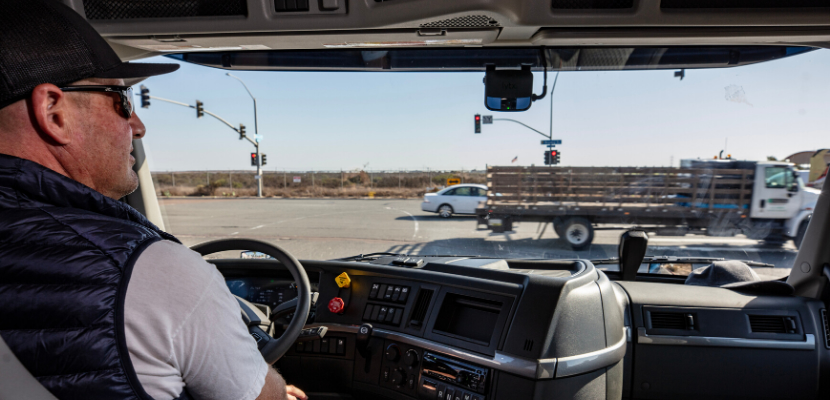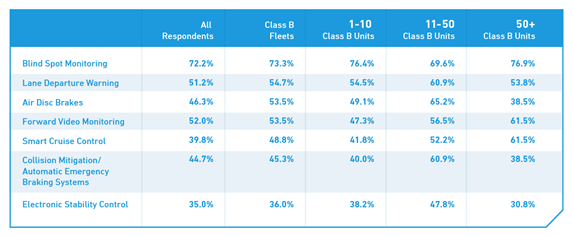What is ADAS? Advanced Driver Assistance Systems Explained

One of the hottest innovations in transportation is advanced driver-assistance systems — or ADAS — with new capabilities continually being launched in the marketplace. That’s good news for fleets, which stand to benefit from the added safety and efficiencies of ADAS technology as part of their fleet management toolkit.
But the speed of change can make it challenging for fleet operators to keep up with the latest developments and how they apply to commercial vehicles. This article walks you through the swiftly changing landscape and gives a glimpse of what to expect as researchers explore the frontiers of fleet safety and driver-assistance technologies.
ADAS can be a game changer for heavy-duty trucks.
What is ADAS?
ADAS (advanced driver-assistance system) refers to any driver assist technology designed to guide drivers in getting to their destinations safely. Although some drivers may not be familiar with the ADAS meaning, most are able to recognize the more mainstream applications, such as adaptive cruise control, automatic emergency braking, blind-spot detection, and forward-collision warning.
The variety and breadth of ADAS technology and its capabilities continue to expand as new technologies emerge that stem from research in the field of autonomous and semi-autonomous vehicles. Self-parking[1] is one example of a technology that was initially developed with autonomous vehicles in mind and is now being introduced in regular passenger vehicles as a premium driver assist feature.
What about ADAS for fleets?
It’s not just passenger vehicles that have adopted ADAS. About 4 out of every 10 commercial fleets with Class 8[2] (heavy truck) vehicles have deployed trucks with advanced driver assistance systems, such as blind-spot monitoring, lane-departure warning, collision-mitigation systems, adaptive cruise control, air disc brakes, electronic stability control, and video monitoring, according to a 2018 survey[3] conducted by Fleet Owner and Informa Engage Research. Large fleets with 50 or more Class 8 vehicles report the highest adoption of ADAS technologies, at 73.7 percent, while small fleets with 10 or fewer Class 8 trucks are at 23.2 percent.
.png)
ADAS features
Typically, ADAS features are first introduced in passenger vehicles before they become options for commercial fleets, two to three years later. Additional time is often required to evaluate and adapt ADAS technologies to the complexities of commercial driving and the variety of vehicles involved compared with consumer cars and trucks.
ADAS features can be generally categorized as either active or passive.
Passive ADAS features
The driver is alerted to changing conditions such as the presence of another vehicle in a blind spot or other object-detection capabilities. Alerts can take several forms, from sound and visual cues to haptic feedback (rumble on the steering wheel or driver’s seat). The driver is in complete control over how he or she will react to the information.
Active ADAS features
The driver is given an advance warning, but if the driver does not react, the ADAS intervenes to avoid or mitigate a collision.
How does ADAS work?
Some would argue that ADAS technologies are paving the way for autonomous vehicles.[4] With passive ADAS, the deployment of sensors to gather information about a vehicle’s immediate environment is a key first step for self-driving vehicles. Once ADAS technologies start to actively intervene, either by slowing down the vehicle with automated braking or helping the driver to steer using lane keep assistance, they begin to shift into the first stage of autonomous vehicle development.
ADAS fleet management: today and the future
Similar to any new risk management solution, the adoption of ADAS systems by commercial fleets has been primarily driven by their return on investment — that is, the benefits of such driver assistance systems as compared to their costs. Active systems, which require integration with the vehicle’s steering and braking systems, in general are more costly and, therefore, take longer to become adopted, than passive systems, which simply monitor conditions.
The list below represents the most common ADAS fleet management technologies deployed and their adoption rates, according to a 2018 survey of commercial-fleet owners.[5] The top three are passive ADAS technologies: blind-spot monitoring, forward video monitoring, and lane-departure warning.
Question: Which of the following safety systems would you add to your new trucks?

Source: Chart 3, 2018 Commercial Vehicle Safety Report, Wards CV Intelligence.
In the next few years, analysts expect to see wider deployment of active ADAS systems as technologies simultaneously improve and decrease in cost.
Over the next five to ten years, commercial-vehicle manufacturers will continue to explore more sophisticated ADAS software functions as part of the industry’s overall drive toward automation and improved safety. Two areas of innovation to watch include vehicle-to-vehicle (V2V) communication and vehicle to infrastructure (V2I) communication, said Gary Johnson, Director of Risk and Compliance Management at Lytx.
V2V technologies, for example, allow trucks to “platoon.” Volvo Trucks North America, working with FedEx, recently completed a successful demonstration[6] of truck-platooning involving three Volvo VNL tractors. In the demonstration, the three vehicles, each pulling double 28-foot trailers, traveled at up to 62 mph while maintaining a time gap of just 1.5 seconds, using V2V communications to coordinate positions.
Vehicle-to-infrastructure (V2I) communication lets vehicles receive real-time traffic information including road closures, accidents along the route, weather conditions, and rerouting information. This allows the driver to make adjustments to conditions as they happen.
Benefits of ADAS features for fleets
Do ADAS features enhance safety? The AAA Foundation for Traffic Safety estimates[7] that advanced truck safety technologies, including lane-departure warning systems, automatic emergency braking, air disc brakes, and video-based onboard safety monitoring systems, have the potential to prevent up to 63,000 truck-related collisions a year.[8]
According to Deborah Hersman, former chair of the National Transportation Safety Board, “ADAS can be a game changer[9] for heavy-duty trucks.
Maximizing the value of your investment in ADAS technologies
Initially, driver acceptance is the primary hurdle for fleets looking to make the most use of their companies’ ADAS investment. Once drivers are on board, however, fleets face the opposite hurdle: overreliance on the technologies to keep them safe, according to Johnson.
“We’re seeing instances of drivers looking down to text and waiting until the lane-departure alert goes off before they look up,” Johnson said.
Another example occurs with automatic-braking systems.
“Drivers are letting the system brake for them when they need to stop or slow down,” he said. “They learn to over-rely on technology to the detriment of their skills.”
This is why safety experts are focused on driver training during the transition to autonomous vehicles. As more ADAS features roll out, drivers will need to be coached to adjust to combat complacency and inattention, as well as to keep their defensive driving skills sharp.
“It’s critical that fleets be vigilant about new types of risky behavior as drivers adapt to vehicle technologies in unintended ways,” Johnson cautioned. “With video telematics systems, you can see into the driver’s world to determine if systems are being applied as they should and invest in driver coaching as a way to counter “behavioral adaptations”[10] that can nullify the safety benefits of new driver safety technologies.
ADAS for fleets
Lytx products work with your installed ADAS to target common driving behaviors. It captures video and data based on your vehicles’ existing ADAS automotive sensors and signals. This better enables you to:
- Uncover previously undetected risky driving behaviors
- Coach drivers to help them improve
- Prevent collisions and reduce accident severity
- Improve compliance and CSA scores
- Lower operating costs and improve your bottom line
Talk with an expert to see how you can maximize the ROI of your ADAS systems with Lytx’s video telematics solutions.
[1] Igor E. Paromtchik, Christian Laugier. “Motion Generation and Control for Parking an Autonomous Vehicle,” INRIA Rhone-Alpes, LIFIA/IMAG.
[2]“Truck Classification.” Wikipedia, Wikimedia Foundation, 2 June 2019,
[3] Mele, Jim. “Will Fleets Turn to Advanced Safety Tech for Improvement?” Fleet Owner, 4 Oct. 2018.
[4] Estl, Hannes, and ADAS Texas Instruments. “How ADAS Is Paving the Way for Autonomous Driving.” Electronic Component News, 29 Nov. 2018.
[5] 2018 Commercial Vehicle Safety Report, Wards CV Intelligence. 2018.
[6] “Volvo Trucks and FedEx Successfully Demonstrate Truck Platooning on NC 540 | Volvo Trucks USA.” Volvo Trucks and FedEx Successfully Demonstrate Truck Platooning on NC 540 | Volvo Trucks USA.
[7] “Truck Safety Technology Can Prevent 63,000 Crashes Each Year.” AAA NewsRoom, 19 Sept. 2017
[8] Camden, M.C., Medina-Flintsch, A., Hickman, J.S., Miller, A.M. & Hanowski, R.J. (2017). Leveraging Large-Truck Technology and Engineering to Realize Safety Gains. AAA Foundation for Traffic Safety.
[9] Advanced Driver Assistance Systems: Strategies for Increasing Commercial Vehicle Adoption Roundtable Discussion, August 1, 2017, National Safety Council, National Transportation Safety Board.
[10] Sullivan, John M. (2016). Overview of Behavioral Adaptation Research and ADAS Reaching Zero Crashes: A Dialogue on the Role of Advanced Driver Assistance Systems. University of Michigan Transportation Research Institute.

